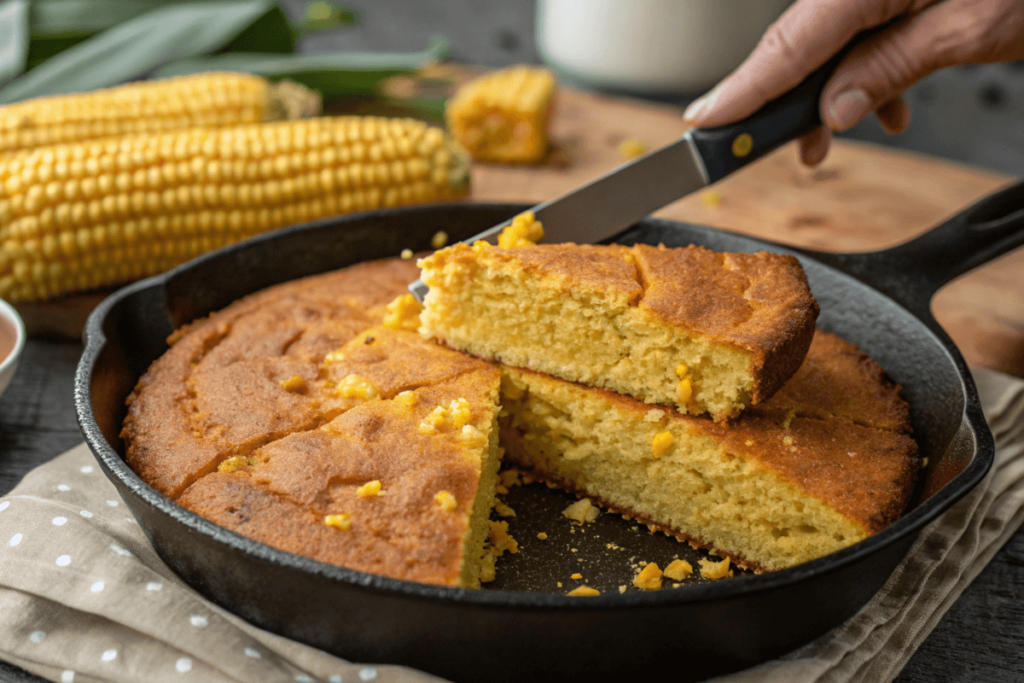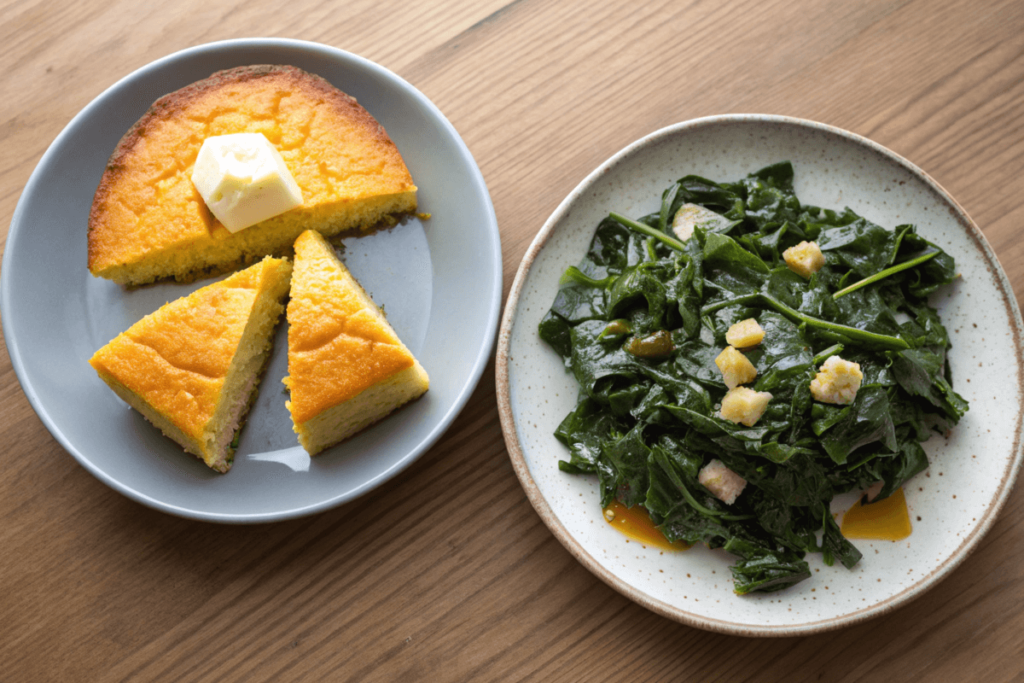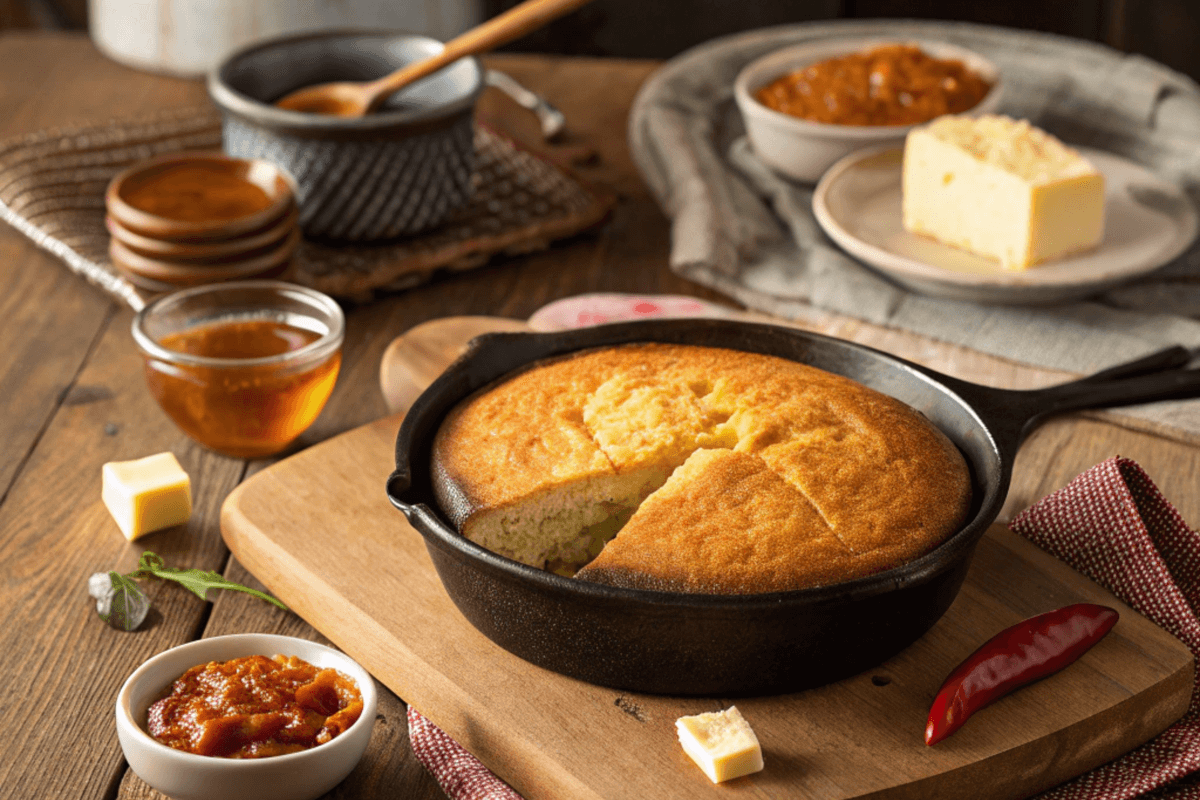The Difference Between Cornbread and Southern Cornbread lies in their unique ingredients, textures, and cultural significance. While both share a common history, their regional variations have created two distinct styles that continue to spark debate. In this article, we’ll uncover what sets these two classics apart.
Origins and Historical Context of Cornbread
The Origins of Cornbread
Cornbread traces its roots back to Native American cooking, where ground corn (maize) was a dietary cornerstone. Early settlers adopted these methods, using locally available ingredients to create a simple, filling bread. Over time, cornbread became a symbol of resourcefulness and adaptability in American kitchens.
How Southern Cornbread Emerged as a Distinct Variation
As the South developed its own culinary identity, Southern cornbread evolved. The abundance of white cornmeal and buttermilk in the region gave this version its distinct dense texture and savory flavor. Unlike its Northern counterpart, Southern cornbread often omitted sugar, reflecting a focus on savory dishes rather than sweet ones.
The Influence of Regional Ingredients on Cornbread Styles
In the North, the availability of yellow cornmeal and a penchant for sweeter dishes influenced cornbread recipes. Molasses and sugar became common additions, leading to a lighter, cake-like bread. Meanwhile, in the South, the use of cast iron skillets to create crispy edges became a hallmark of Southern cornbread, highlighting its rustic and hearty nature.
Key Ingredients and Recipe Differences
Base Ingredients: White vs. Yellow Cornmeal
The choice between white and yellow cornmeal significantly influences cornbread’s flavor and appearance. Southern cornbread traditionally utilizes white cornmeal, yielding a subtler corn flavor and a lighter hue. Conversely, Northern versions often prefer yellow cornmeal, imparting a robust corn taste and a golden color. This distinction contributes to the regional variations in cornbread.

Sweetness Debate: The Role of Sugar in Northern Cornbread
A notable difference between cornbread styles is the inclusion of sugar. Northern cornbread recipes typically incorporate sugar or molasses, resulting in a sweeter, cake-like bread. In contrast, traditional Southern cornbread omits sugar, focusing on savory flavors. This divergence reflects regional taste preferences and culinary traditions.
Buttermilk and Eggs: The Southern Staples
In the South, buttermilk and eggs are essential components of cornbread. Buttermilk adds a tangy flavor and tender crumb, while eggs provide structure and moisture. These ingredients contribute to the dense, moist texture characteristic of Southern cornbread. Northern recipes may use regular milk and fewer eggs, leading to a lighter texture.
Baking Methods: Cast Iron vs. Baking Pans
The cooking vessel plays a crucial role in cornbread’s crust and texture. Southern cooks often use preheated cast-iron skillets, creating a crispy, golden crust. This method enhances the bread’s rustic appeal. In contrast, Northern cornbread is frequently baked in standard baking pans, resulting in a softer crust and uniform texture.
Texture, Flavor, and Appearance Comparison
Northern Cornbread: Light, Sweet, and Cake-like
Northern cornbread is known for its light, airy texture and pronounced sweetness. The addition of sugar and a higher proportion of flour contribute to its cake-like consistency. This style is often enjoyed as a standalone treat or paired with sweet accompaniments like honey or jam.
Southern Cornbread: Dense, Savory, and Flakey
In contrast, Southern cornbread boasts a dense, crumbly texture with a savory flavor profile. The absence of sugar and the use of buttermilk and white cornmeal result in a bread that’s flakey and rich. It’s commonly served alongside savory dishes such as greens, beans, or fried chicken, complementing the meal without overpowering it.
Visual Differences: White vs. Golden Yellow Hue
Visually, the two styles of cornbread are distinguishable by color. Southern cornbread, made with white cornmeal, typically has a pale, creamy appearance. Meanwhile, Northern cornbread’s use of yellow cornmeal gives it a vibrant, golden hue. These visual cues, along with texture and flavor differences, highlight the regional distinctions in cornbread preparation.
Cultural and Culinary Significance
Cornbread in Southern Cuisine
Cornbread holds a special place in Southern cooking, serving as more than just a side dish. This hearty bread often accompanies iconic dishes like collard greens, fried chicken, and barbecue. Its savory, crumbly texture complements the rich, flavorful nature of Southern meals. In family gatherings, cornbread becomes a centerpiece, symbolizing comfort and tradition.
In the South, recipes for cornbread are often passed down through generations, reflecting the region’s strong sense of culinary heritage. Whether served fresh from a cast-iron skillet or crumbled into a bowl of potlikker, Southern cornbread remains a staple of authentic Southern cooking.
Northern Cornbread in American Comfort Food
In contrast, Northern cornbread often features in comfort food menus across the country. Its sweeter flavor and cake-like texture make it a versatile addition to meals, from Thanksgiving feasts to casual weekday dinners. Northern cornbread is frequently paired with chili, soups, and stews, providing a sweet counterbalance to spicy or savory dishes.
Beyond the table, cornbread has woven itself into American culture. Its versatility and simplicity make it a beloved symbol of home-cooked meals and comfort food traditions, transcending regional boundaries.
Cornbread’s Role in Family Gatherings and Celebrations
Whether sweet or savory, cornbread is a go-to dish for holidays, potlucks, and reunions. In both Northern and Southern households, it represents community and togetherness. Families often have their own unique twists on recipes, leading to lively debates about what is the difference between cornbread and Southern cornbread. This dish’s enduring popularity stems from its ability to bring people together and celebrate culinary diversity.
Health and Dietary Considerations
Nutritional Differences Between Northern and Southern Cornbread
The nutritional profiles of Southern cornbread and Northern cornbread vary based on ingredients. Southern cornbread, with its lack of sugar, tends to have fewer calories and less sugar per serving. The use of white cornmeal and buttermilk provides a rich source of fiber and protein, making it a relatively wholesome choice.
On the other hand, Northern cornbread’s inclusion of sugar or molasses increases its calorie count. However, the lighter texture may appeal to those looking for a more dessert-like bread. Whether you’re seeking a savory or sweet option, both styles can be adapted to fit dietary needs.
Gluten-Free and Vegan Variations of Cornbread
For those with dietary restrictions, cornbread can easily be customized. Gluten-free recipes using almond or coconut flour are becoming increasingly popular. Similarly, vegan adaptations replace buttermilk with almond milk and eggs with flaxseed substitutes. These options ensure that everyone can enjoy this beloved dish, regardless of their dietary needs.
For more inspiration, explore our collection of delicious cornbread recipes to find one that suits your tastes and preferences.
FAQs
Why is Southern Cornbread Traditionally Unsweetened?
One of the most common questions in the debate about what is the difference between cornbread and Southern cornbread revolves around sugar. Southern cornbread is traditionally unsweetened because it was designed to pair with savory dishes rather than act as a stand-alone item. Historically, sugar was less accessible in the South, and cooks relied on the natural sweetness of cornmeal and buttermilk to flavor their recipes. This tradition continues today, with many Southern cooks staunchly opposing the addition of sugar in their cornbread.
Can You Make Northern Cornbread Without Sugar?
Yes, you can omit sugar from Northern cornbread, but it significantly changes the flavor. Northern cornbread, with its sweet, cake-like texture, depends on sugar or molasses to achieve its signature taste. Without sugar, the bread becomes more similar to its Southern counterpart, although the lighter texture remains. This option is ideal for those who want a savory cornbread but prefer the fluffiness of Northern recipes.
What is the Best Cornmeal for Southern Cornbread?
For authentic Southern cornbread, white cornmeal is often the top choice. White cornmeal has a milder flavor, creating a more neutral base that pairs perfectly with savory dishes. However, some modern recipes also use yellow cornmeal for a slightly sweeter flavor and golden appearance. Regardless of your preference, stone-ground varieties are highly recommended for their coarse texture and richer flavor.
How Do You Achieve the Perfect Texture for Either Style?
The secret to achieving the perfect texture lies in the preparation. For Southern cornbread, using a preheated cast-iron skillet ensures a crispy crust, while buttermilk and eggs create a dense, crumbly texture. For Northern cornbread, incorporating more flour and sugar results in a light, fluffy bread. Mixing the batter just enough to combine ingredients is also crucial, as overmixing can lead to a dense, gummy texture.
Conclusion
A Bread for Every Table
The debate over what is the difference between cornbread and Southern cornbread highlights the diversity in American culinary traditions. Whether you prefer the sweet, fluffy texture of Northern cornbread or the savory, dense crumb of its Southern counterpart, both versions have their place on the table.
Cornbread’s ability to adapt to regional tastes and personal preferences makes it a versatile staple. From holidays to weeknight dinners, it brings people together with its comforting flavors and nostalgic appeal. By understanding the differences in ingredients, preparation methods, and cultural significance, you can appreciate both styles and perhaps even try blending the best of both worlds.
So, why choose? Bake a batch of each and let your taste buds decide! For more delicious bread recipes and cooking tips, explore our extensive collection of ideas to elevate your culinary creations.
Serving Suggestions and Pairings
Pairing Southern Cornbread with Savory Dishes
Southern cornbread’s savory, crumbly texture makes it the perfect companion for hearty meals. Traditionally, it’s served alongside collard greens, black-eyed peas, or slow-cooked meats like pulled pork or fried chicken. The dense nature of Southern cornbread also makes it ideal for crumbling into soups, stews, or chili, adding flavor and substance.
To elevate your Southern cornbread, try spreading a pat of butter on a warm slice or drizzling it with honey for a subtle hint of sweetness. This combination highlights the bread’s rustic flavor while complementing savory main courses.

Enjoying Northern Cornbread as a Sweet Treat
In contrast, Northern cornbread is often enjoyed as a sweeter side dish or even as a dessert. Its light, fluffy texture pairs beautifully with honey butter, maple syrup, or fruit preserves. Serve it warm with a dollop of whipped cream or a sprinkle of cinnamon for a comforting finish to any meal.
Northern cornbread also shines as a standalone snack. Its sweetness makes it a versatile option for breakfast, brunch, or an afternoon treat. Whether paired with coffee, tea, or a cold glass of milk, this bread satisfies cravings any time of day.
A Blend of Both Worlds
If you’re curious about what is the difference between cornbread and Southern cornbread but can’t decide which to try, consider blending elements of both. Combine the lightness of Northern recipes with the savory richness of Southern traditions for a unique twist.
Why the Debate Matters
Preserving Culinary Traditions
The debate over what is the difference between cornbread and Southern cornbread isn’t just about recipes; rather, it’s deeply rooted in preserving culinary traditions. Indeed, cornbread reflects the rich history, vibrant culture, and diverse regional preferences that define American cooking. Moreover, these differences highlight the creativity and adaptability of cooks across generations. By examining these variations, we not only understand the flavors but also appreciate the stories and legacies behind them. Thus, the debate transcends the kitchen, serving as a testament to the enduring significance of food in connecting people and preserving heritage.
Embracing Regional Diversity
By exploring both Northern and Southern cornbread styles, you can celebrate the diversity of American cuisine. Each variation offers a glimpse into the tastes and traditions of its region. While the North embraces sweetness and lightness, the South focuses on hearty, savory flavors. Together, they represent the broad spectrum of flavors that make cornbread a beloved staple.
Cornbread as a Unifier
At its core, cornbread is about bringing people together. Whether at a family gathering, a holiday table, or a casual potluck, it sparks conversation and fosters connections. The debate over its variations only strengthens its appeal, inviting more people to share their own take on this classic dish.

